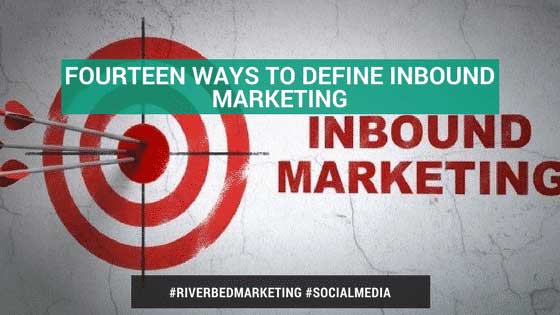There’s no getting around it – the biggest trend and perhaps the most important aspect of today’s digital advertising world is inbound marketing. Typically considered as a way of marketing by educating, entertaining, and pulling in current and prospective customers via highly relevant content such as blogs, eBooks, videos, webinars, case studies, white papers, social media posts, podcasts, and other materials designed to help consumers solve their problems. Furthermore, inbound marketing requires the audience to discover it themselves via search, social media, subscribing to a list and opening an email(s) or similar “pull” techniques.
On the contrary, outbound marketing “pushes” messaging at consumers – think print advertising, billboards, TV commercials, radio ads, banner ads, and pop-ups. While these types of ads most certainly have their uses and can be successful, the marketing world is increasingly choosing to focus on techniques that reward the users who are searching for what they have to offer and who opt in.
Table of Contents
ToggleEach Inbound Marketing Influencer with their Own Spin on the Methodology
What’s more, inbound marketing is more of a philosophical mindset than a set technique or standardized system. Therefore, it is up to each professional to define it for themselves. But that said, there’s certainly nothing wrong with drawing inspiration from the experts. So without further adieu, here’s how some of the leaders in the field describe inbound marketing.
Seth Godin
Although he’d probably rather refer to it as permission marketing, this is how one of “America’s greatest marketers” and authors defines inbound marketing:
“Permission marketing is the privilege (not the right) of delivering anticipated, personal and relevant messages to people who actually want to get them.” Visit Seth’s Website here
Brian Halligan
The founder and CEO everyone’s favorite marketing automation software giant Hubspot describes inbound marketing as such:
“Rather than doing outbound marketing to the masses of people who are trying to block you out, I advocate doing “inbound marketing” where you help yourself “get found” by people already learning about and shopping in your industry…the best analogy I can come up with is that traditional marketers looking to garner interest from new potential customers are like lions hunting in the jungle for elephants. The elephants used to be in the jungle in the ’80s and ’90s when they learned their trade, but they don’t seem to be there anymore. They have all migrated to the watering holes on the savannah (the internet). So, rather than continuing to hunt in the jungle, I recommend setting up shop at the watering hole or turning your website into its own watering hole.” Learn more about Brian here
Dharmesh Shah
Halligan’s business partner and CTO of Hubspot on inbound marketing (and the two are co-authors who literally wrote the book on the subject)
“Some of you might be wondering: Why come up with the term “inbound marketing” anyways? Didn’t the world have enough marketing terms already? Was a new term necessary? I have wondered that a lot—back then, and even now. When we first coined the term inbound marketing (this was 8 years ago, three years before we published the first book), we were looking for a way to describe the set of marketing activities that we considered organic and empathetic. The activities themselves existed long before we ever came along. Savvy marketers had being doing SEO, social media, blogging—all the things that were the opposite of pushing messages out to people that they didn’t want. But as it turns out, there really wasn’t a term to capture that collection of activities. So we made one up and start calling those activities “inbound marketing.” Learn more about Dharmesh here
Simon Sinek
Another expert on consumer and employee psychology, and inbound marketing, Simon Sinek recommends that you play on the biological needs or the subconscious minds of your consumers – fueling their basic needs and being a leader can be one of the most effective marketing tactics. As he says:
“You think business is about contracts – it isn’t. It’s about human beings looking for others around which they can feel safe.” Learn more about Simon here
Rand Fishkin
The creator of the foremost search engine optimization and SEO resource – Moz.com – has plenty of valuable thoughts on inbound marketing.
“I just really like inbound marketing because I get really tired of saying SEO and social media and content marketing and email and CRO and branding and PR and all the other things you can do on the web to earn traffic and attention that don’t directly cost money.” Find out more about Rand here
Chris Brogan
The social media consultant, journalist, author, and overall blogging guru recognizes that inbound marketing is really the ultimate way for a consumer to opt into receiving your message:
“The biggest value of inbound marketing is earning the right to outbound market and direct sell.” Learn more about Chris at his website
Mike Volpe
The CMO of Hubspot, Mike Volpe has been performing inbound marketing miracles since before it became an industry buzzword. And he has some wise words for anyone else in the field on some of the biggest mistakes that companies attempting to utilize inbound marketing make, and his report on the state of inbound marketing is an excellent read as well:
“The biggest mistakes that companies make…is to assume people know something about them. Don’t assume people know what your company does when they’re watching a video on a deep page on your website. Don’t assume they saw your last product press release before reading the new one. Don’t assume they are sick of your message or positioning just because you are.” Learn about Mike Volpe on his website
Leslie Bradshaw
This talented marketer helps companies and individuals tell stories with their brand – and that’s what inbound marketing is really all about. She also speaks to the importance of creative visuals…
“One of the most important things that small businesses can do is start to experiment with visual storytelling. Take one of your blog posts or one of your emails and think “how can I turn this into something visual? Is it taking a couple photos, working with a graphic designer to bring it to life, is it using some sort of metaphor to describe the actual concept? Whatever it is, make some graphics, put it out there on social media, use Instagram or Facebook – wherever the audience you’re trying to reach goes. Fish where the fish are.” Follow Leslie on Twitter @LeslieBradshaw
Chris Guillebeau
Perhaps the most unique individual on our list, Chris has made a career of selling his ideas – which is one of the most vital elements of a successful inbound marketing campaign. And his optimism, positivity, and overall style is downright inspiring, making his blog a must-read for advertisers and brand managers in general.
“I just prefer to operate from a perspective of abundance. Freely give, freely receive. Why force people to join a list before reading my work? Some of them would resent that, and the commitment level of the others would be pretty weak. Why inspire people with something and then tell them that they need to pay me each month to “really” get what I have to say?” Learn more about Chris on his blog.
David Berkowitz
The CMO at MRY and speaker and columnist on all things advertising related likens inbound marketing (or content marketing) to storytelling:
“The future of storytelling isn’t about telling anyone anything. It’s about storymaking, where the brand facilitates and taps into the stories people are creating and sharing with each other. Storytelling is the epitome of the old one-way, broadcast mindset that so many of us in marketing are trying to leave behind. Storymaking, by contrast, is far more fulfilling, and exactly what will matter to the people all of our brands are trying to reach.” Follow David’s Blog for more information.
Marcus Sheridan
The “Sales Lion” himself advocates defined inbound marketing as anything but the actual phrase in order to get the buy-in from your team, your boss, and the C-Suite:
“Most people don’t know “what” the correct description is for a blog – but a blog is simply formatted information. So “how” do you get content out of your team members—all of them? Everyone is a teacher. They have a voice. They have skills. Just get them to write a few paragraphs in a Word document and turn it in. Crazy things will happen. It is our job to inform, educate and convince; that collective knowledge is the job of the team as a whole—it’s just a matter of getting them to write.” Check out Marcus Sheridan’s website for more information about him.
Hugh MacLeod
Cartoonist, artist, blogger, author, and all around creative type (and former big agency copywriter) Hugh MacLeod has this to say about the subject:
“Inbound Marketing” means creating stuff that makes people want to come and find you and your product, as opposed to you going out and finding them (the latter being an increasingly expensive process etc, etc).” Read more about Hugh here
Tim Ferriss
There’s no way we can sum up the inbound marketing prowess of author, speaker, and general motivator Tim Ferriss in a single quote, but we can try. He focuses on being human first and foremost – which is important advice for marketers to remember since it builds an innate sense of trust.
“Transparency is important in content — email or otherwise, he added, and “if you haven’t emailed in a long time, don’t make up some corporate reason for it … have a human interaction and not a corporate interaction. People trust people more than they trust brands, so be a human.” Check out Tim’s website to learn more
Guy Kawasaki
And we’ll conclude with a dose of realism and perspective on budgets from marketing expert, blogger, and author Guy Kawasaki:
“If you have more money than brains, you should focus on outbound marketing. If you have more brains than money, you should focus on inbound marketing.”
Learn more about Guy Kawasaki
At the end of the day, inbound marketing can be summed up in a relatively simple fashion – it is any type of branded content that aims to educate & inspire the consumer to click and convert by pulling them in and offering solutions to their problems – on their terms and at the times and places that best fit their needs.











